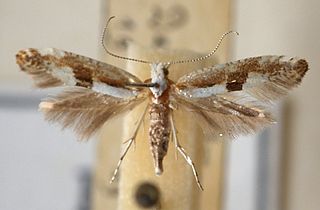
Apamea monoglypha, the dark arches, is a moth of the family Noctuidae. The species was first described by Johann Siegfried Hufnagel in 1766. It is a common, sometimes abundant, European species. It is found in most of Europe except northernmost Fennoscandia and the southern parts of the Iberian Peninsula and Greece. The species is also found in Anatolia, Turkestan, Western Asia and Central Asia, Siberia and Mongolia. In the Alps it is found up to heights of 2,500 meters. The smaller subspecies sardoa is found on Sardinia and Corsica.

Hippotion celerio, the vine hawk-moth or silver-striped hawk-moth, is a moth of the family Sphingidae. It was described by Carl Linnaeus in his 1758 10th edition of Systema Naturae.

Argyresthia bonnetella is a moth of the family Yponomeutidae. It is found in Europe. The wingspan is 9–11 mm.The head is white. Forewings are shining ochreous-whitish, usually strigulated and sometimes discally suffused with ferruginous brown; a suffused ferruginous -brown median longitudinal streak from base to before middle ; a curved dark ferruginous- brown fascia from middle of dorsum to 4/5 of costa, sometimes obsolete except on dorsum. Hindwings are grey. The larva is yellow-green ; head and plate of 2 brown.

Crambus perlella is a species of moth of the family Crambidae. It is found in Europe and east across the Palearctic.

Falcaria lacertinaria, the scalloped hook-tip, is a moth of the family Drepanidae. The species was first described by Carl Linnaeus in his 1758 10th edition of Systema Naturae It is found in Europe and Anatolia then east to Eastern Siberia.

Hulodes caranea is a species of moth of the family Erebidae first described by Pieter Cramer in 1780. It is found from India, Sri Lanka, Myanmar, Java, Hong Kong to Queensland and New Guinea, it is also found on the Marianas and Carolines.

Mesapamea secalis, the common rustic, is a moth of the family Noctuidae. The species was first described by Carl Linnaeus in his 1758 10th edition of Systema Naturae. It is found in Europe, north-west Africa, Turkey and northern Iran.

Acrapex brunnea is a species of moth of the family Noctuidae first described by George Hampson in 1910. It is found in Africa, including Angola, Kenya and South Africa.

Agrochola helvola, the flounced chestnut, is a moth of the family Noctuidae. It was first described by Carl Linnaeus in his landmark 1758 10th edition of Systema Naturae. The species is found in most of Europe, north to Scotland and Fennoscandia up to the Arctic Circle, south to Spain, Sicily, Greece further east to the Middle East, Armenia, Asia Minor, western Turkestan and central Asia up to central Siberia.

Phalonidia manniana is a moth of the family Tortricidae. It is found in most of Europe.

Actinotia intermediata is a species of moth of the family Noctuidae. It is found in Asia, including India, Sri Lanka and Taiwan.
Ebbepterote is a monotypic moth genus in the family Eupterotidae. It was erected by Rolf G. Oberprieler, Wolfgang A. Nässig and Edward David Edwards in 2003. Its only species, Ebbepterote expansa, was described by Thomas Pennington Lucas in 1891. It is found in Australia, where it has been recorded from Queensland.
Anacampsis petrographa is a moth of the family Gelechiidae. It was described by Edward Meyrick in 1922. It is found in Brazil (Para).
Anacampsis anisogramma is a moth of the family Gelechiidae. It was described by Edward Meyrick in 1927. It is found in China (Shanghai).
Anacampsis homoplasta is a moth of the family Gelechiidae. It was described by Edward Meyrick in 1932. It is found in Japan and Russia.
Anacampsis inquieta is a moth of the family Gelechiidae. It was described by Edward Meyrick in 1914. It is found in Guyana.
Anacampsis cornifer is a moth of the family Gelechiidae. It was described by Thomas de Grey, in 1897. It is found in the West Indies.
Anacampsis conistica is a moth of the family Gelechiidae. It was described by Thomas de Grey, 6th Baron Walsingham, in 1910. It is found in Mexico.
Anacampsis phytomiella is a moth of the family Gelechiidae. It was described by August Busck in 1914. It is found in Panama.
Psittacastis stigmaphylli is a moth in the family Depressariidae. It was described by Lord Walsingham in 1912. It is found on Jamaica.









